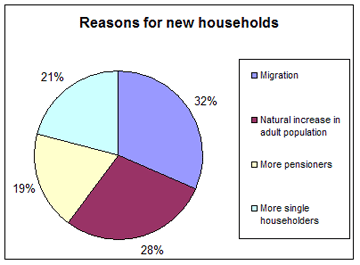Why do we need nearly 5 million new homes?
19 March, 2006
Introduction1. The government's massive house building programme will affect every community in the country. It is therefore important to understand why (and whether) it is necessary.
2. Projections of households for England published by the Office of the Deputy Prime Minister (ODPM) on 14 March 2006[1] estimate that 4.8 million new households will form between 2003 and 2026, an annual growth of 209,000 [2].
3. There are four major reasons for this extra demand as shown in the diagram below:
| Immigration | 32% |
| More adults | 28% |
| More single households | 21% |
| More pensioners | 19% |
It should be noted that immigration was not mentioned in the ODPM document as a reason for the growth in households.

Immigration
4. The ODPM statistical release attributes 123,000 of the additional households per year to adult population growth, 43,000 to more single households and 39,000 to more pensioners.
5. The projections of adult population include the effect of immigration. They assumed a net inflow of 130,000 people per year (to the UK as a whole). They also calculated the housing need on an assumption of zero net migration (i.e. immigration and emigration in balance). Under this scenario the average annual increase in the number of households would be 144,000 instead of the primary projection of 209,000 a year. The difference is the effect of immigration - 65,000 additional households each year. That amounts to 1.5 million over the period 2003 - 2026, or nearly a third of the total new households [3].
More adults
6. The natural increase in adult population is a result of the age structure of the existing population. The overall adult population of the UK, even assuming no net migration, will continue to rise until about 2027 before stabilising [4].
More pensioners
7. The changing age distribution is caused by the ageing of the population with the number of people of pension age continuing to rise for the foreseeable future. This causes an increase in households because many pensioners form single person households. The increase in pensioners and in the adult population account for nearly half of the increase in households. These are demographic trends which can be predicted with some certainty.
More single households
8. There has for some time been a trend towards more single person households, either because of divorce or by reason of personal choice. The projections assume that current trends will continue into the future but this is far less certain than the demographic factors outlined above and can be influenced only to a limited extent by public policy.
The impact of immigration
9. Migration, which is predicted to account for 32% of new household formation, is, in contrast, very much influenced by government policy. A reduction of one third in household formation from this source would be extremely significant. In response to the Barker Report, the government increased their house building target from 150,000 to 200,000 houses a year [5]. Since immigration, on their own calculations, adds 65,000 houses a year it would be unnecessary to increase the house building target in this way if there was a policy of no net immigration.
10. A further important consideration is the extent to which it will become necessary to build on green field sites. The target of 60% of house building on brown field sites by 2008 was achieved in 2000 [6]. And in 2004 72% of new house building was on previously developed land or conversions. Again, it follows that the 32% extra demand stemming from immigration is largely responsible for the need to build on green field sites.
Conclusions
11. Of the four major factors contributing to the growth of households (para 3 above), the increase in adults and pensioners is an inevitable result of the present age structure of the population while the social trend towards more people living alone can only be marginally influenced by public policy.
12. We conclude therefore that a policy of balanced migration (immigration and emigration broadly in balance) is the only effective means of reducing the pressure which the demand for new housing is placing on the environment. It would eliminate the need for the government's massive recent increase in the housing programme and would alleviate the need for much of the green field development planned for England.
12. Such a policy would not signify an end to immigration or even an overly restrictive immigration policy. Over the period 2000-2004 an average of 80,000 British citizens have emigrated each year [7] giving scope for a similar number of immigrants to keep overall migration flows in balance while very significantly easing the pressure on housing and related infrastructure.
Footnotes
| [1] | ODPM Statistical Release 2006/0042 |
| [2] | A household is defined as: |
| [3] | Even this could turn out to be an underestimate. The government have already had to increase their immigration assumption to 145,000 for the UK and the present actual level is 222,000. |
| [4] | Source Government Actuary’s Department: 2003-based natural change variant population projection |
| [5] | The government’s response to Kate Barker’s review of housing supply, December 2005 page 4. |
| [6] | Source : From Campaign for Protection of Rural England website Land Use Change statistics, October 2005 |
| [7] | Source ONS: News Release 20 October 2006 |
